
Ball Milling Jars
Retrieved: 12/28/2014
As with most home-made tooling, there are many ways to make milling jars. I have yet to see a design I like better than this one which uses PVC pipe and fittings. The jars are very sturdy and will last for many years. Their initial description was supplied by Lloyd Sponenburgh.

The quart size jar uses 4 inch PVC and fittings. It is the smallest and cheapest jar to construct. However, its milling capacity is so small that it is only useful for small batch, specialty milling. This is the parts list: a 4 inch end cap, a 5 inch length of 4 inch I.D. schedule 40 PVC pipe, a 4 inch to 3 inch reducer, a short stub length of 3 inch I.D. PVC and a rubber test cap with band clamp.

The above parts are all glued together with PVC glue to yield this result. As you can see, the jar with the flat end cap is nice because it will stand up by itself. If you use a rounded end cap, I recommend putting 3 rubber feet on the bottom of the end cap to stabilize it. The rounded end cap also results in a larger capacity jar. The actual total capacity of the flat bottomed jar is about 1 quart plus 1/2 cup. It will require a volume of 1 pint plus 1/4 cup of milling media and will yield a charge of 1 and 1/8 cups of milled powder. This illustrates the Sponenburgh rule of thumb for milling jar capacity which is: Fill your jar half full of milling media to mill a charge of 1/4 of the jar volume.
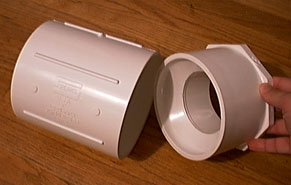
The 5 inch jar is about right for most of my milling jobs. The same parts as above are needed, but in the 5 inch sizes. There are a few quirks, however. The supplier in my area does not carry a simple 5 inch to 3 inch reducer. The reducer shown fits inside the 5 inch coupler. This requires the addition of the coupler to the above parts list. The other complication is that there are lots of ridges and raised lettering on the outside of the coupler that have to be removed to achieve a smooth outer surface on the jar.
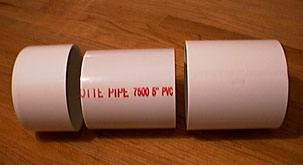
Shown here is the rounded end cap, a 6 inch length of 5 inch I.D. PVC and the coupler with the raised ridges removed. A radial arm saw was used to remove the ridges, but a belt sander would probably work better.
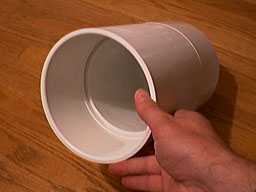
When these three parts are glued together, the 6 inch length of pipe becomes entirely enclosed by the coupler and endcap because the distance of insertion into each one is 3 inches.
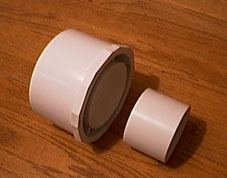
The reducer is prepared by clipping off the corners which otherwise would protrude beyond the outer surface of the jar. A short length of 3 inch PVC is cut so that 3/4 inches will protrude for the attachment of the rubber test cap lid. Note that the lid in the next picture has been trimmed back to a width of 3/4 inches to make it much easier to attach and remove.
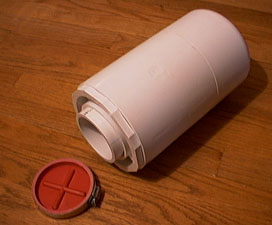
The final volume of this jar is 3 1/4 quarts and the charge capacity is 3 1/4 cups. Again, the addition of stick-on rubber feet to the bottom of the rounded end cap is recommended. A few final notes: Mill jars, like screens should be reserved for certain classes of milling. I have separate jars for milling black powder, oxidizers, (chlorates get their very own jars) benzoates and binders. Care should be taken with your milling media, as well, to avoid cross contamination. I use ceramic media to mill most single substances. Lead media is used to mill black powders, rocket fuels and charcoal. This same approach can be used to make milling jars of 1 gallon capacity by using 6 inch PVC pipe and fittings. The drawback is that a jar of this size will require 30 pounds of lead milling media. That represents a big pain in my back to lug around and in my wallet to purchase the media.
Date: Tue, 24 Nov 1998
From: " Mike N." (705728@ican.net)
I couldn't find the rubber end caps in my area, but the 3" ABS test caps fit right on the outside diameter of the 4" to 3" adapter tightly, no clamp required.
Date: Fri, 19 Nov 1999
From: Dave Armstrong (armstrong.david@mcleodusa.net)
I have read information indicating that PVC will not show on X-Ray. This requires exploratory surgery to locate fragments in the human body as PVC will cause severe infection if not removed.
To solve the problem I purchased a six inch HDPE mortar, cut it into 14 inch lengths and purchased six inch pipe plugs to close the ends. The plug is called "Gripper" and is manufactured by Cherne Industries, Inc. They come in various diameters. I purchased the 6 inch plug at Schimberg Co., a plumbing supply company, here in Cedar Rapids, Iowa for $16.91. These are kind of costly, but these jars are very easy to clean and if detonation were to occur there would be no risk of shrapnel.
Date: Wed, 15 Aug 2001
From: "Harris, Mike"
I have a tip on stabilizing ball milling jars. Instead of applying rubber sticky feet to the jars, just cut an inch or so tall cylinder of the same pipe used in the jar and glue this to the convex bottom of the endcap. This results in a very stable base that is accurate and also very durable.
Regards, Mike